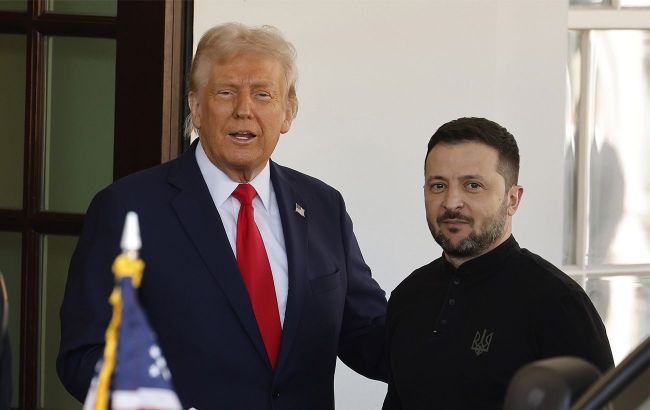What Ukraine promises to US in minerals deal and how reconstruction fund will operate
 Photo: Donald Trump and Volodymyr Zelenskyy (Getty Images)
Photo: Donald Trump and Volodymyr Zelenskyy (Getty Images)
After several months of negotiations, Ukraine and the US signed the so-called minerals deal. The government has published the official text of the document, which includes the creation of the reconstruction investment fund. Its money will be invested in Ukrainian natural resources and infrastructure.
Details about the fund's operation, financial obligations, and the rights of the parties are collected by RBC-Ukraine.
Takeaways
-
What commitments has Ukraine made in the minerals deal?
-
How will the joint Ukrainian-American fund operate?
-
What contributions are the parties required to make to the fund?
-
What special legislative conditions will be provided for the operation of the fund?
-
What rights will the American side have?
-
What has Ukraine already received from signing the deal with the US?
Creation of the reconstruction fund
The deal signed in Washington provides for the creation of the reconstruction investment fund, a financial organization that will receive funds from two donors – Ukraine and the US. The fund will invest money in the extraction of natural resources and infrastructure projects in Ukraine. All subsoil and natural resources will remain under Ukraine’s control.
As reported by Deputy Prime Minister and Minister of Economy, Yuliia Svyrydenko, on her Facebook page, the fund will be managed jointly by Ukraine and the US on an equal basis. "The fund will be created 50/50. Neither party will have a prevailing vote, and this will reflect the equal partnership between Ukraine and the United States," the official commented.
The officially published text of the agreement does not provide information on the fund's governance structure. This will likely be outlined in subsequent agreements. According to Yuliia Svyrydenko, the fund will be managed by three members from the US and three from Ukraine.
Ukraine and the US's contribution to the fund
Compared to previous demands from Washington, the current agreement does not include any debts from Ukraine to the US for past periods, meaning that contributions to the fund from the US will be made in the future – assistance already provided will not be counted.
According to the published text of the agreement, the US may contribute to the fund in the form of weapons, ammunition, technologies, and military training. The value of this military aid will be counted as part of the US contribution.
"In addition to direct funds, they may also contribute with NEW assistance – for example, air defense systems for Ukraine," Yuliia Svyrydenko noted.

Photo: Signing of the agreement on the creation of the investment fund between the US and Ukraine (Facebook page of Yuliia Svyrydenko)
The agreement does not specify the exact financial obligations of the US, such as the amounts of funds or the value of weapons that the American side is required to contribute to the fund.
However, the agreement clearly outlines Ukraine's financial obligations, which include transferring 50% of the state budget's revenue from rent (tax) payments and from the sale of special permits for exploration and extraction of natural resources, as well as revenue from other forms of subsoil usage.
The agreement stipulates that the fund will only receive budget revenues from new licenses, meaning that existing projects and their budget contributions will remain under Ukraine's control. Income generated by the fund, as well as potential reparations from Russia, will not be counted as contributions from Ukraine.
Where the fund will invest
The contributions received from the parties will be invested by the fund in the extraction of natural resources and infrastructure projects in Ukraine. The fund's income will not be subject to taxation and cannot be alienated by the fund based on a decision of a Ukrainian court.
Hryvnia income will be freely convertible into dollars and will not be subject to currency restrictions imposed by the National Bank of Ukraine when transferred to the fund's accounts, which may be opened both in Ukraine and abroad. The location of the fund's bank accounts will be determined by future agreements. If the conversion of hryvnias into dollars threatens Ukraine's balance of payments and macro-financial stability, the Ukrainian side, after consultations with the US Department of the Treasury, may "take reasonable measures in the form of restrictions on the conversion of hryvnia into dollars."
According to the available text, the fund will make investments only within Ukraine. "The partnership (the fund's shareholders – ed.) will invest in projects within Ukraine," the document states. Details on how the funds should be invested and which funds will be distributed to shareholders will be outlined in subsequent agreements.

Photo: The agreement signed between the US and Ukraine provides for investments in subsoil resources and infrastructure (Facebook page of Yuliia Svyrydenko)
The text provides an extensive list of minerals in which the fund can invest for extraction projects. For example, it includes rare-earth metals (such as hafnium, cobalt, and others), as well as important energy resources – oil, gas, and uranium. It is important to note that the list of minerals does not include kaolin, iron ore, rent, and other income sources, which currently contribute significantly to the state budget.
Special rights for US partners
The text also mentions that Ukrainian companies initiating projects and seeking investments for the extraction of natural resources or significant infrastructure projects will need to notify the fund of their financing needs.
Furthermore, the Ukrainian company will be required to negotiate with the fund about securing its funding and refrain from "offering any third party significantly more favorable financial or economic terms." As a result, the fund will receive information about major investment projects (both in extraction and infrastructure) and will have the preferential right to invest in them compared to other investors.
American partners will also have the first right to purchase extracted raw materials from the Ukrainian company. Our company cannot offer its products to third parties at better prices than those offered to US companies.
Terms and conditions of the deal
Deputy Prime Minister Yuliia Svyrydenko stated that the agreement will define cooperation between Ukraine and the US for decades. "We expect that for the first 10 years, the profits and revenues of the fund will not be distributed but can only be invested in Ukraine – in new projects or reconstruction. These conditions will be discussed further," Yuliia Svyrydenko wrote.

Photo: Investment projects in the extraction of natural resources in Ukraine must first be proposed to the US (Getty Images)
At the same time, the official text of the agreement does not specify any timeframes. "This Agreement remains in effect until the Parties agree to its termination," the document states.
The Agreement does not provide for the resolution of disputes in international arbitration. "To the extent that a dispute arises regarding the interpretation or application of this Agreement, such dispute shall be resolved by mutual consultation," the text of the document reads. Amendments to the Agreement may be made by mutual consent of the parties.
State-owned companies and their revenues will not be involved in the fund or the agreement. This means that the US will not receive a share in state assets, despite previous proposals from US Treasury Secretary Scott Bessent.
"Companies such as Ukrnafta and Energoatom remain state-owned," commented Yuliia Svyrydenko.
The agreement retains a provision from the memorandum signed in mid-April by Kyiv and Washington, stating that the agreement will not contradict Ukraine's European integration goals or its Constitution. Additionally, a point from the memorandum was carried over into the text of the agreement, specifying that Ukraine will not adopt legislation that would hinder the implementation of the agreement or create less favorable conditions for it.
The text of the agreement notes that the agreement has precedence over Ukrainian legislation. "Further, the Government of Ukraine agrees that it may not invoke the provisions of its internal law as justification for any failure to perform its obligations under this Agreement," the document states.
Further ratification of the deal
Under this framework agreement, two additional technical agreements will be signed to ensure the functioning of the fund. These agreements will be concluded between the US International Development Finance Corporation (DFC) and the Ukrainian Agency for the Promotion of Public-Private Partnership, which was established in 2019 and operates under the Ministry of Economy.

Photo: The fund will receive contributions from budget revenues from oil and gas extraction in Ukraine (press center of Naftogaz of Ukraine)
"To implement this agreement, there will be so-called executive agreements between the US government company DFC and the Ukrainian agency, that is, sectoral agreements. They will be executive in addition to the main agreement," explained Prime Minister Denys Shmyhal during a national telethon live broadcast.
According to Deputy Prime Minister and Minister of Economy Yuliia Svyrydenko, the launch of the fund will require amendments to the Budget Code. As noted by Member of Parliament and member of the parliamentary committee on finance, tax, and customs policy, Yaroslav Zheleznyak, changes will also be needed to the Tax Code and other laws.
The adopted agreement must be ratified by the Verkhovna Rada (Ukrainian parliament), as it is an international treaty. According to Zheleznyak, the most likely date for ratification is the parliamentary session between May 13-15, as the consideration and ratification of intergovernmental agreements follow a separate procedure that is difficult to expedite. The Reconstruction Fund will start operating after the agreement is ratified and additional agreements are signed.
Significance for relations with Trump
The agreement does not contain information on security guarantees from the US but does mention that the American side recognizes Ukraine's contribution to international security following its renunciation of nuclear weapons in the 1990s.
However, the very fact of signing the agreement contributes to improving relations between Kyiv and Washington. Evidence of this is that after the signing of the agreement, the US State Department sent a notification to Congress regarding a license for the export of weapons to Ukraine valued at 50 million dollars. The signing of the agreement has already unblocked the issue of military aid supply to Ukraine from Donald Trump’s administration. Observers from the British The Times noted that the positive statements from US Treasury Secretary Scott Bessent about the Ukrainian side have already "reinvigorated faith in Ukraine."

Photo: The US resumes arms sales to Ukraine after signing the agreement (Getty Images)
Thus, while the agreement contains provisions that give certain economic advantages to American partners, its signing already weakens the cold stance of the White House administration toward Kyiv, which had lasted quite a long time.
Further delays in the delivery of American military aid would only worsen Ukraine's situation on the battlefield. The signing of the agreement, on the contrary, paves the way for the supply of American weapons and military technologies to Ukraine, as well as continued support from the US if the war continues. Ukraine can position itself as a reliable and responsible partner among Washington's decision-making circles.

